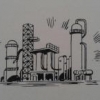|
|
Estimate Amount Of Acid/base Required
#1

Posted 24 April 2015 - 12:23 AM
#2

Posted 24 April 2015 - 04:08 AM
Hi ,
My advice , do the work in the lab .
Take a sample , have a pH Probe calibrated and perform the neutralization . For a volume of WW ,let say z , you need x cc of HCL ( concentration ??)) to reach pH from 8 to 7 >>> x/y .
Apply this rule to your flow rate to get the flow rate of HCL.
Breizh
#3

Posted 30 April 2015 - 12:40 AM
Dear Breizh,
Thanks for taking the trouble to answer.
I agree doing a lab test and subsequently scaling up is probably the most direct method but I am kind of preparing a general template (with the amount required changing depending on the composition of the wastewater) and therefore I am approaching it from a "book" approach.
Appreciate the effort anyways.
Regards,
AY
Hi ,
My advice , do the work in the lab .
Take a sample , have a pH Probe calibrated and perform the neutralization . For a volume of WW ,let say z , you need x cc of HCL ( concentration ??)) to reach pH from 8 to 7 >>> x/y .
Apply this rule to your flow rate to get the flow rate of HCL.
Breizh
#4

Posted 30 April 2015 - 09:56 AM
Perhaps it has just been too long, but it seems to me that this problem has echos of all those acid/base problems from your introductory chemistry courses. I would probably first suggest that you pull up your old intro to chemistry texts and review the chapter(s) describing acid/base chemistry. (http://www.chem1.com...df/c1xacid1.pdf ).
From there, you should recall what pH means (and pOH) and how those numbers relate to H+ and OH- concentration. If it is applicable to your wastewater stream, you may want to review material related to weak acids, weak bases, buffers, and the Henderson-Hasselbach equation.
If you have any questions or difficulties recalling those concepts and calculations, let us know. Whatever you do, though, do not ask me that triprotic phosphoric acid question that my professor kept putting on his quizzes and tests, because I never could get that one right.
#5

Posted 30 April 2015 - 11:30 AM
The "book" answer for how much acid is needed to change the pH of a real wastewater stream may not be that useful. What is in your wastewater stream? The stream is something other than pure H2O or the ph would not be 8. The amount of acid to add depends on the buffering quality of the stream. For example, an aqueous solution of baking soda has a pH of about 8 and will require a relatively large amount of acid to bring the pH to 7. On the other extreme, the pH of demineralized water will change drastically with just a little bit of acid. The amount of acid to add will vary with wastewater composition. Titrate a sample to find out.
#6

Posted 02 May 2015 - 01:11 AM
Aaron,
In my plant also, I have calculated theoretical acid/ base required for bringing pH of waste water to 7. But, the actual amount of acid/ base required will be two to three time more than the calculated value. Its quite difficult to know what are the components present in waste water. If you know exactly what are the ions present in the water and their percentage, then you can calculate a near amount of acid/ base.
#Samayaraj
Edited by samayaraj, 02 May 2015 - 01:11 AM.
#7

Posted 03 May 2015 - 10:42 PM
Dear all,
thanks for the reply thus far, they have all been useful to respective extents.
I agree that the composition of the wastewater plays a large part and that echoes what Pilesar and Samayaraj has said. And what Mr Shorty mentioned about the fact that basic chemistry plays a part here is also true.
For acid requirement, I summarize my ideas as follows:
Acid requirement = amt acid required to cause the pH change (1) + amt of acid required to overcome the alkalinity of the water (2)
(1) acid required to cause pH change would come from the basic definition of pH = -log10[H+] so for e.g. if I wish to reduce the pH from 8 to 7, I would need to increase the [H+] by ten times. Taking into account the volume, the amt H+ required could then be estimated and this would come from acid addition.
(2) amt acid required to overcome alkalinity of water: I have the alkalinity of the wastewater for my plant measured (as meq/L), from this, I can convert the alkalinity to mg CaCO3/L basis. Based on stoichiometry, I can then work out how much acid I need to overcome the alkalinity.
Can someone who is strong in chemistry help affirm if the above makes sense?
I am now 100% regretful that I have not paid more attention during the chemistry classes during the good old days... ![]()
I am kind of stucked when calculating base requirement. While I can still calculate the amt base required to change the [H+] and thus pH, I am not aware if the "acidity" (as opposed to alkalnity) is readily available.
Once again, appreciate the help and advice rendered.
Aaron
#8

Posted 04 May 2015 - 11:20 AM
If that is really all the information you have, then I guess it is as good as any other. Speaking from outside the wastewater neutralization business:
1) Why assume alkalinity exists as carbonate/bicarbonate/carbonic acid? If you look at titration curves for this system, you will see that at pH 8 you are right in between the pKa's of 6 and 10 of this diprotic acid system. pH is changing quite rapidly in this region with the addition of strong acid.
2) If you review the Henderson Hasselbach equation as I suggested, you will recall that buffers resist changes to pH. As acid or base is added to a buffer, pH change is slowest when pH=pKa of that acid. The farther you are from pKa, the faster pH will change. I expect that a big part of this calculation is what "buffer" you assume is present and what its pKa is. As a review of this principle, I might suggest that you assume some "hypothetical" buffers with different pKa's (6,6.5,7,7.5) at whatever concentration of "buffer" that you think is present and calculate how much acid it would take assuming these different buffers. If you have forgotten how to use the Henderson-Hasselbach equation in performing these calculations with simple buffers, I would suggest that you put "henderson-hasselbach equation buffers" into your favorite internet search engine for some valuable tutorials on the subject.
Recognizing some of the severe simplifying assumptions we have made (we can approximate the system as a single, simple buffer at a specified formal concentration), I would expect this would give you some different estimates of the amount of acid needed, as well as the uncertainty in that amount of acid.
The uncertainty can be reduced by getting better data about the system (the exact nature and concentration of all species).
At some point, the effort needed to calculate this may become more than would be required to simply titrate a representative sample, as has been suggested by others.
#9

Posted 08 May 2015 - 09:01 AM
Dear AaronY,
I send information that can you help, from "Calculation&Shotcut Deskbook", published by Chemical Engineering, p. 50-51.
Regards,
Napo.
Attached Files
Similar Topics
Sulphuric Acid H2So4 Storage TankStarted by Guest_TeeEng_* , 08 Apr 2024 |
|

|
||
Time Required To Heat Up A Fluid In A VesselStarted by Guest_panagiotis_* , 24 Jan 2023 |
|

|
||
Sulfuric Acid PlantStarted by Guest_Kartik54_* , 16 Mar 2024 |
|

|
||
Linear Alkyl Benzene Sulfonic Acid Production (Labsa) SimulationStarted by Guest_Emranm02_* , 03 Mar 2024 |
|

|
||
Aspen Edr Error Data BaseStarted by Guest_adrich91_* , 31 Jan 2024 |
|

|

 FB
FB











